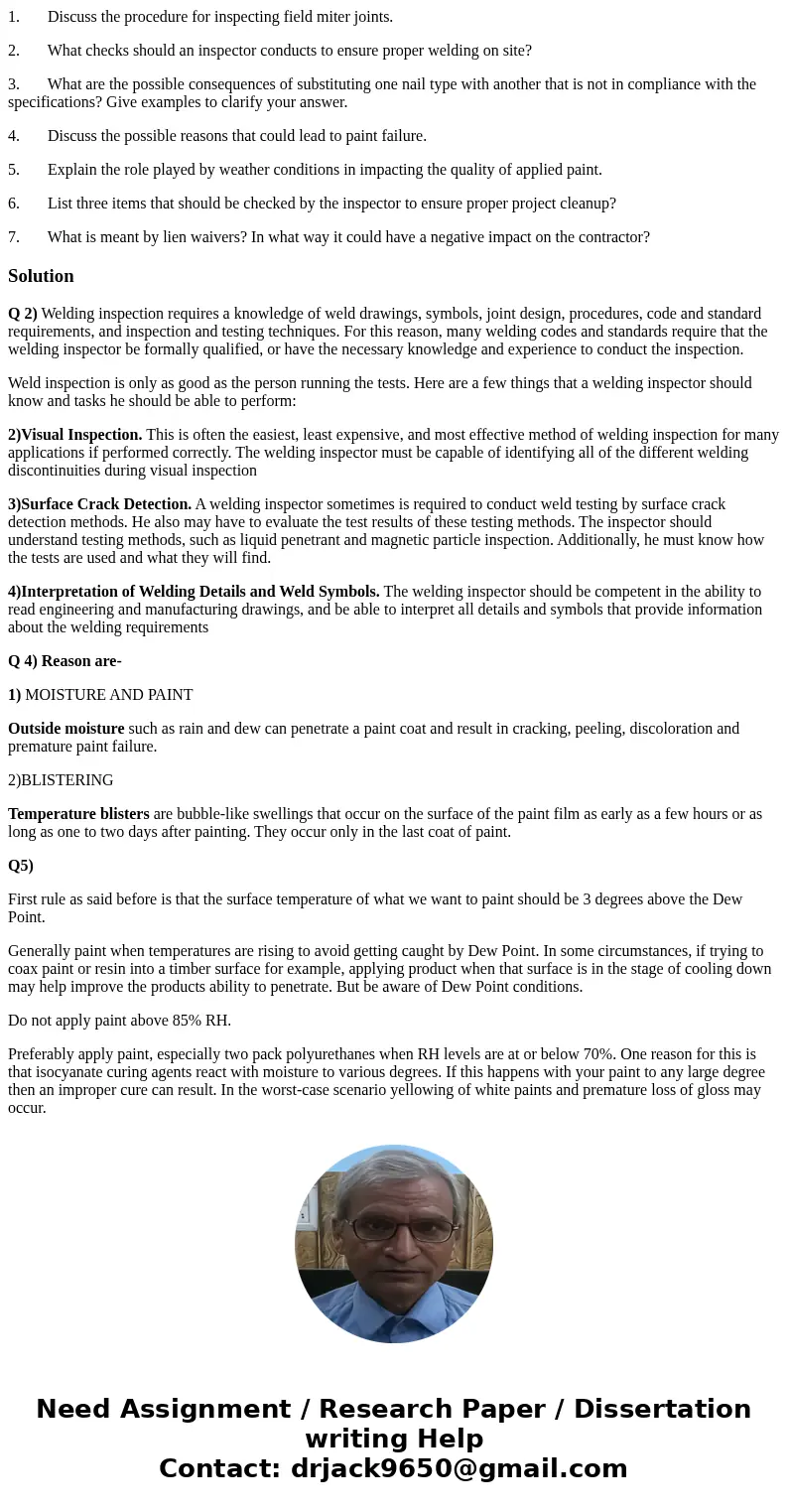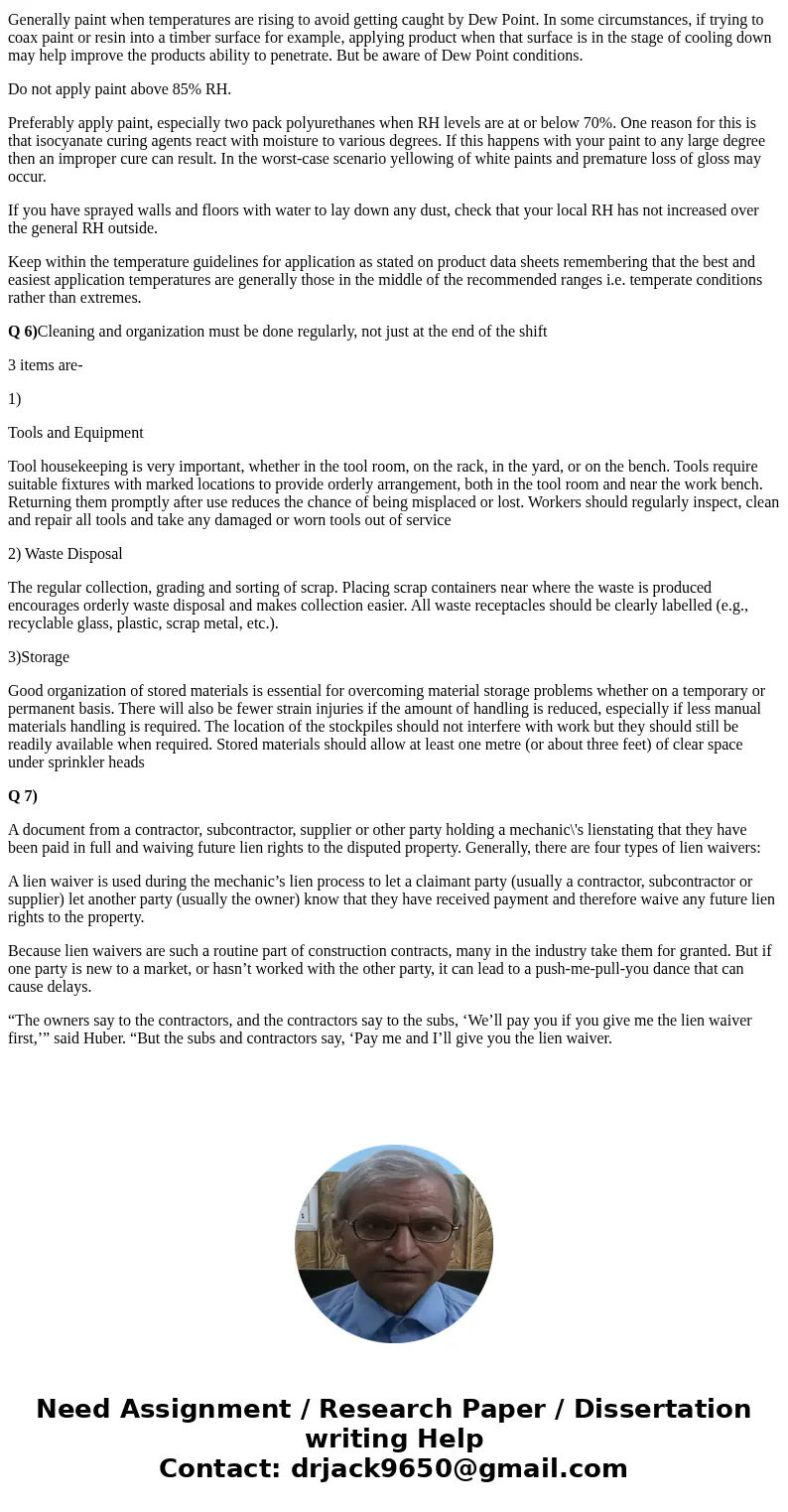1 Discuss the procedure for inspecting field miter joints 2
1. Discuss the procedure for inspecting field miter joints.
2. What checks should an inspector conducts to ensure proper welding on site?
3. What are the possible consequences of substituting one nail type with another that is not in compliance with the specifications? Give examples to clarify your answer.
4. Discuss the possible reasons that could lead to paint failure.
5. Explain the role played by weather conditions in impacting the quality of applied paint.
6. List three items that should be checked by the inspector to ensure proper project cleanup?
7. What is meant by lien waivers? In what way it could have a negative impact on the contractor?
Solution
Q 2) Welding inspection requires a knowledge of weld drawings, symbols, joint design, procedures, code and standard requirements, and inspection and testing techniques. For this reason, many welding codes and standards require that the welding inspector be formally qualified, or have the necessary knowledge and experience to conduct the inspection.
Weld inspection is only as good as the person running the tests. Here are a few things that a welding inspector should know and tasks he should be able to perform:
2)Visual Inspection. This is often the easiest, least expensive, and most effective method of welding inspection for many applications if performed correctly. The welding inspector must be capable of identifying all of the different welding discontinuities during visual inspection
3)Surface Crack Detection. A welding inspector sometimes is required to conduct weld testing by surface crack detection methods. He also may have to evaluate the test results of these testing methods. The inspector should understand testing methods, such as liquid penetrant and magnetic particle inspection. Additionally, he must know how the tests are used and what they will find.
4)Interpretation of Welding Details and Weld Symbols. The welding inspector should be competent in the ability to read engineering and manufacturing drawings, and be able to interpret all details and symbols that provide information about the welding requirements
Q 4) Reason are-
1) MOISTURE AND PAINT
Outside moisture such as rain and dew can penetrate a paint coat and result in cracking, peeling, discoloration and premature paint failure.
2)BLISTERING
Temperature blisters are bubble-like swellings that occur on the surface of the paint film as early as a few hours or as long as one to two days after painting. They occur only in the last coat of paint.
Q5)
First rule as said before is that the surface temperature of what we want to paint should be 3 degrees above the Dew Point.
Generally paint when temperatures are rising to avoid getting caught by Dew Point. In some circumstances, if trying to coax paint or resin into a timber surface for example, applying product when that surface is in the stage of cooling down may help improve the products ability to penetrate. But be aware of Dew Point conditions.
Do not apply paint above 85% RH.
Preferably apply paint, especially two pack polyurethanes when RH levels are at or below 70%. One reason for this is that isocyanate curing agents react with moisture to various degrees. If this happens with your paint to any large degree then an improper cure can result. In the worst-case scenario yellowing of white paints and premature loss of gloss may occur.
If you have sprayed walls and floors with water to lay down any dust, check that your local RH has not increased over the general RH outside.
Keep within the temperature guidelines for application as stated on product data sheets remembering that the best and easiest application temperatures are generally those in the middle of the recommended ranges i.e. temperate conditions rather than extremes.
Q 6)Cleaning and organization must be done regularly, not just at the end of the shift
3 items are-
1)
Tools and Equipment
Tool housekeeping is very important, whether in the tool room, on the rack, in the yard, or on the bench. Tools require suitable fixtures with marked locations to provide orderly arrangement, both in the tool room and near the work bench. Returning them promptly after use reduces the chance of being misplaced or lost. Workers should regularly inspect, clean and repair all tools and take any damaged or worn tools out of service
2) Waste Disposal
The regular collection, grading and sorting of scrap. Placing scrap containers near where the waste is produced encourages orderly waste disposal and makes collection easier. All waste receptacles should be clearly labelled (e.g., recyclable glass, plastic, scrap metal, etc.).
3)Storage
Good organization of stored materials is essential for overcoming material storage problems whether on a temporary or permanent basis. There will also be fewer strain injuries if the amount of handling is reduced, especially if less manual materials handling is required. The location of the stockpiles should not interfere with work but they should still be readily available when required. Stored materials should allow at least one metre (or about three feet) of clear space under sprinkler heads
Q 7)
A document from a contractor, subcontractor, supplier or other party holding a mechanic\'s lienstating that they have been paid in full and waiving future lien rights to the disputed property. Generally, there are four types of lien waivers:
A lien waiver is used during the mechanic’s lien process to let a claimant party (usually a contractor, subcontractor or supplier) let another party (usually the owner) know that they have received payment and therefore waive any future lien rights to the property.
Because lien waivers are such a routine part of construction contracts, many in the industry take them for granted. But if one party is new to a market, or hasn’t worked with the other party, it can lead to a push-me-pull-you dance that can cause delays.
“The owners say to the contractors, and the contractors say to the subs, ‘We’ll pay you if you give me the lien waiver first,’” said Huber. “But the subs and contractors say, ‘Pay me and I’ll give you the lien waiver.


 Homework Sourse
Homework Sourse